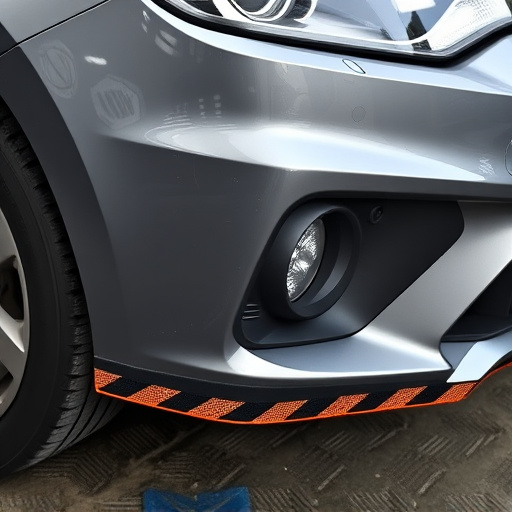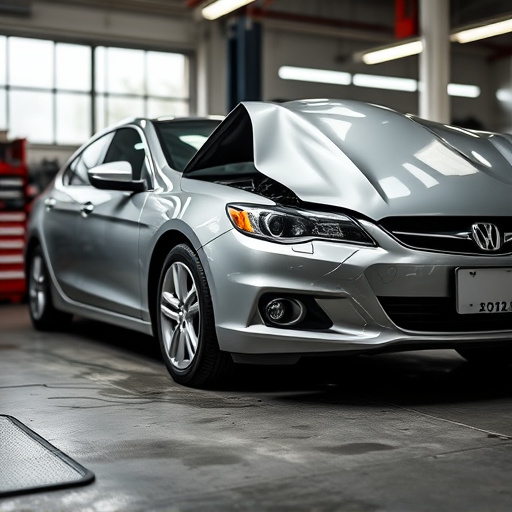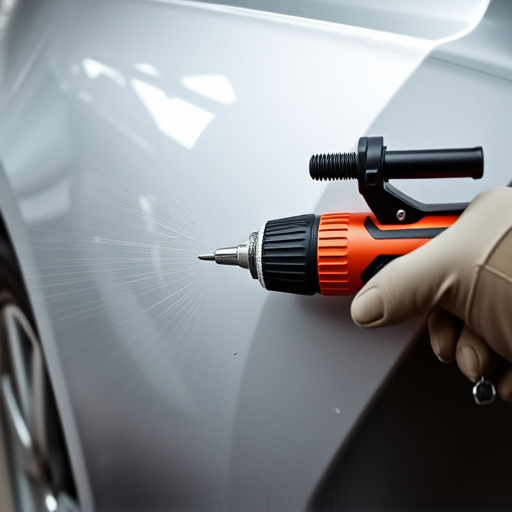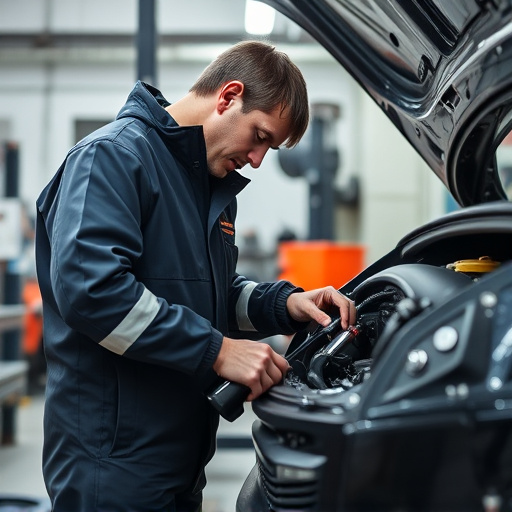Tesla Speed Limiter Precision: Calibration’s Impact on Safety

Tesla performance calibration is crucial for optimizing speed limiter safety and efficiency. Precise…….
In the rapidly evolving landscape of automotive technology, Tesla has emerged as a pioneer in electric vehicle (EV) performance and innovation. At the heart of this revolution lies ‘Tesla Performance Calibration,’ a sophisticated process that fine-tunes the dynamics and efficiency of their electric machines. This article aims to delve into the intricate world of Tesla performance calibration, exploring its every facet, from technical intricacies to global implications. We will navigate through its historical development, technological breakthroughs, economic impact, regulatory landscape, and future prospects, providing valuable insights for industry stakeholders, researchers, and enthusiasts alike.
Tesla performance calibration is a meticulous process that involves fine-tuning various parameters of a Tesla vehicle to optimize its overall performance and driving experience. It encompasses a comprehensive analysis of the electric motor, power electronics, battery management system, and vehicle dynamics. The primary goal is to achieve a perfect balance between acceleration, top speed, energy efficiency, and driver engagement, ensuring Tesla vehicles deliver exceptional performance while adhering to safety standards.
Historically, Tesla has been at the forefront of EV technology, continuously refining its calibration processes with each new model. The company’s early focus on software-over-hardware allowed for rapid iteration and improvement, setting a new benchmark in electric vehicle performance. This approach has led to impressive achievements, such as remarkable acceleration times and extended range, solidifying Tesla’s position as a leader in the EV market.
Core Components:
Motor and Power Electronics: Tesla utilizes advanced AC induction motors known for their efficiency and high torque output. Calibration involves tuning motor parameters like stator voltage, rotor design, and power supply to achieve optimal performance.
Battery Management System (BMS): The BMS is critical in ensuring the battery’s health and maximizing its energy delivery. Calibration techniques optimize charging algorithms, cell balancing, and temperature management to enhance range and overall battery longevity.
Vehicle Dynamics: This includes suspension tuning, tire selection, and brake calibration. Tesla engineers meticulously adjust these components to achieve ideal handling, stability, and driver comfort during high-performance driving conditions.
Software and Control Systems: Tesla’s proprietary software plays a pivotal role in performance calibration by enabling precise control of vehicle dynamics. Over-the-air updates further enhance this process, allowing for remote tuning and feature enhancements.
Tesla’s performance calibration technology has left an indelible mark on the global automotive industry, influencing both traditional manufacturers and start-ups alike. Its success has sparked a worldwide trend of electric vehicle adoption, with governments and consumers alike embracing sustainable mobility solutions.
North America: Tesla’s home market has seen rapid EV penetration, driven by consumer demand for high-performance electric vehicles. The company’s performance calibration strategies have contributed to the region’s leadership in EV technology.
Europe: With stringent emission regulations and government incentives, Europe is a hub for EV innovation. Tesla’s presence and calibration techniques have played a significant role in raising the bar for electric vehicle performance on the continent.
Asia-Pacific: Countries like China and Japan are rapidly expanding their EV markets, with Tesla establishing strong footprints. The region’s diverse driving conditions present unique challenges, which Tesla addresses through tailored performance calibration for each market.
Range and Efficiency: Global trends focus on increasing EV range and improving efficiency, with manufacturers striving to deliver vehicles that can match or exceed the iconic Tesla Model S’s range. Performance calibration plays a crucial role in achieving these goals.
Autonomous Driving: The integration of advanced driver assistance systems (ADAS) and autonomous driving capabilities is a global priority. Tesla’s performance calibration contributes to the development of highly responsive, safe, and efficient self-driving vehicles.
Sustainable Materials: There is a growing emphasis on using sustainable materials in vehicle construction, which also influences battery and motor design. Tesla is at the forefront of this trend, continuously exploring eco-friendly alternatives for its performance calibration components.
The economic implications of Tesla performance calibration are far-reaching, influencing both the automotive industry and global energy sectors.
Competitive Landscape: Tesla’s performance calibration advancements have intensified competition within the EV market. Traditional automakers have responded by investing heavily in their own EV technologies to match or surpass Tesla’s offerings. This competitive dynamic drives innovation and improves consumer choices.
Supply Chain and Manufacturing: The complex supply chain for EV components, including motors, batteries, and electronic systems, has led to increased collaboration between suppliers and manufacturers. Tesla’s performance calibration requirements have influenced the development of specialized components, creating new business opportunities.
Research and Development (R&D): Tesla’s commitment to continuous improvement in performance calibration has driven significant R&D investments. These efforts have led to breakthroughs that not only enhance their own vehicles but also benefit the industry as a whole.
Infrastructure Development: The growing EV market necessitates the expansion of charging infrastructure, which attracts substantial investment. Tesla’s performance calibration data and feedback contribute to strategic location planning for these stations, ensuring optimal user experience.
Job Creation: The development and production of advanced electric vehicles and their associated technologies have created numerous job opportunities, from engineering and manufacturing to research and design.
Energy Sector Transformation: Tesla’s performance calibration contributes to the decarbonization of transportation, reducing reliance on fossil fuels. This shift has significant implications for the energy sector, encouraging investment in renewable energy sources and smart grid infrastructure.
Tesla’s performance calibration journey is a testament to continuous technological progress, with each iteration building upon the last.
Advanced Battery Technology: Tesla has been at the forefront of battery development, introducing solid-state batteries that promise higher energy density, faster charging, and longer lifespans. These breakthroughs will revolutionize performance calibration by offering improved range and reduced degradation over time.
Motor Efficiency and Design: The company’s in-house motor design and advanced cooling systems have led to significant efficiency gains. Future developments may include more compact and lightweight motors, further enhancing vehicle dynamics and performance.
Autonomous Driving Capabilities: Tesla’s Autopilot system, powered by advanced sensors and machine learning, is a key aspect of its performance calibration ecosystem. Continuous improvements in this area enhance driver safety and open up new possibilities for autonomous driving regulations and infrastructure.
Quantum Computing Applications: Quantum computing, though still in its early stages, could revolutionize battery optimization and predictive maintenance, further enhancing Tesla’s performance calibration capabilities.
Artificial Intelligence (AI): AI algorithms can analyze vast amounts of vehicle data to predict and prevent failures, optimize energy consumption, and personalise performance settings for individual drivers.
5G Connectivity: The integration of 5G technology will enable faster communication between vehicles and infrastructure, facilitating real-time performance tuning and over-the-air updates, enhancing the overall EV ownership experience.
The development of Tesla performance calibration is not just a technical endeavor but also falls within the realm of policy and regulation, ensuring consumer safety, environmental protection, and fair competition.
Emission Standards: Governments worldwide have implemented stringent emission regulations, pushing automakers to develop more efficient EVs. Tesla’s performance calibration plays a vital role in meeting these standards while delivering impressive driving dynamics.
Safety Norms: Vehicle safety is a critical aspect of regulation, with crash testing and advanced driver assistance systems (ADAS) being mandatory in many regions. Tesla’s performance calibration includes rigorous testing to ensure vehicles meet or exceed safety requirements.
Data Privacy and Security: As EVs collect vast amounts of data, privacy and security regulations are essential. Tesla must adhere to data protection laws while leveraging vehicle data for performance improvements and personalized experiences.
Incentives and Subsidies: Many governments offer financial incentives and subsidies for EV purchases, encouraging adoption. Tesla’s performance calibration and market positioning impact the effectiveness of these policies.
Charge Infrastructure Development: Regulatory bodies are promoting charging infrastructure growth to support EV adoption. Tesla provides valuable data on driver behavior and range requirements, aiding in the strategic planning of charging stations.
International Cooperation: With global trends toward electric mobility, international cooperation is essential for harmonising standards and regulations. Tesla’s performance calibration data can contribute to these discussions, ensuring consistent consumer experiences across borders.
Despite its remarkable achievements, Tesla performance calibration faces several challenges and criticisms that require strategic solutions.
Range Anxiety: Despite significant improvements, range anxiety remains a concern for EV owners. Tesla is addressing this through extended-range models and advancements in battery technology, aiming to provide peace of mind for long-distance travel.
Charging Infrastructure: The availability and accessibility of charging stations can hinder widespread EV adoption. Tesla has taken initiatives to expand its Supercharger network, but collaboration with other charging providers remains crucial to address this challenge.
Cost and Affordability: High vehicle and battery costs have been a point of criticism. Tesla aims to make EVs more accessible through model variations and financial incentives, while also working on cost-effective production methods for new technologies.
Environmental Impact of Battery Production: The environmental footprint of battery manufacturing is a concern. Tesla is actively exploring sustainable mining practices and recycling programs, aiming to minimise the ecological impact of its performance calibration components.
Software Updates and Security: Over-the-air updates raise security concerns. Tesla has implemented robust cybersecurity measures and encourages user feedback to ensure smooth and secure software updates for their performance calibration systems.
Regulatory Compliance Across Borders: Navigating different regulations in various countries can be complex. Tesla’s global presence requires strategic compliance approaches, ensuring their performance calibration meets local standards while maintaining global consistency.
Tesla’s Model 3 is a prime example of successful performance calibration tailored to mass-market preferences. The vehicle offers impressive acceleration (0-60 mph in under 5 seconds) while maintaining excellent range (up to 322 miles). Here’s how Tesla achieved this:
Optimized Motor and Battery Design: The Model 3 utilizes a lightweight, efficient motor design with advanced cooling systems. The battery pack is strategically placed for optimal weight distribution, enhancing handling.
Sophisticated Software Control: Tesla’s software algorithms dynamically adjust power delivery based on driver input, road conditions, and vehicle speed, ensuring a responsive yet stable driving experience.
Aerodynamics: Streamlined aerodynamics, including active air management, contribute to reduced drag, improving both performance and range.
Lessons Learned:
The Tesla Semi is a game-changer in the long-haul trucking industry, showcasing advanced performance calibration for commercial vehicles. With its impressive acceleration (0-60 mph in under 5 seconds) and fuel efficiency, it sets new standards for electric heavy-duty trucks:
Powerful Motor and Battery System: The Semi employs a high-torque motor design, delivering exceptional pulling power while maintaining energy efficiency. The battery system is designed for long-duration operation, supporting extended hauls.
Airbrakes and Aerodynamics: Tesla’s semi-autonomous airbrakes and aerodynamic design reduce drag, further improving fuel economy during long-distance travel.
Autopilot Features: The Semi incorporates Autopilot technology, providing advanced driver assistance for long hours on the road, while also gathering valuable data to enhance future performance calibration.
Key Takeaways:
The landscape of Tesla performance calibration is poised for significant growth and transformation as technology continues to advance. Here are some potential areas of focus for the future:
Sustainable Materials and Manufacturing: As environmental concerns grow, Tesla will likely lead the way in using eco-friendly materials and production methods for its performance calibration components, reducing the carbon footprint of EV manufacturing.
Artificial Intelligence Integration: AI algorithms will play a pivotal role in predicting vehicle maintenance needs, optimizing energy consumption, and personalizing driving experiences based on individual user preferences.
5G and Connected Vehicles: The rollout of 5G networks will enable ultra-fast communication between vehicles and infrastructure, enabling real-time performance tuning and over-the-air updates, enhancing the overall EV ownership experience.
Autonomous Driving Advancements: Tesla’s ongoing development in autonomous driving technology will shape future performance calibration, as self-driving vehicles require different dynamic control systems to ensure safe and efficient operation.
Global Market Expansion: With growing demand for electric mobility worldwide, Tesla will continue its expansion, tailoring its performance calibration strategies to diverse regional needs and preferences.
Tesla performance calibration is not merely a technical specialty but a driving force behind the global transition to sustainable mobility. Through meticulous engineering, innovative technology, and strategic policy engagement, Tesla has set new standards in electric vehicle performance. As the company continues its mission to accelerate the world’s transition to sustainable energy, its performance calibration processes will evolve, benefiting both consumers and the environment.
The future of electric mobility is bright, and Tesla’s ongoing contributions through performance calibration play a pivotal role in shaping this revolution. With each new development, we move closer to a more sustainable, efficient, and exhilarating automotive landscape.
Q: How does Tesla’s performance calibration differ from traditional vehicle tuning?
A: Unlike traditional tuning, which often focuses on maximizing horsepower for racing or drag events, Tesla’s performance calibration is designed to deliver optimal range, efficiency, and safety for everyday driving. It leverages advanced technologies and real-world data to fine-tune the vehicle’s dynamics, ensuring a balanced experience.
Q: Can Tesla performance calibrated vehicles be modified for even better performance?
A: Yes, Tesla provides an over-the-air software update feature that allows owners to access different performance modes. These range from ‘Efficiency’ mode for maximum range to ‘Sport’ or ‘Racing’ modes for enhanced acceleration and handling. However, these modifications are intended for specific use cases and should be used judiciously.
Q: How does Tesla ensure the safety of its vehicles during software updates?
A: Safety is a top priority during software development and updates. Tesla conducts rigorous testing to verify the safety integrity of every update. They also implement measures like rolling out updates in phases, allowing them to monitor performance and gather feedback before full deployment. User consent is required for each update, ensuring informed decision-making.
Q: Will future Teslas be fully autonomous?
A: Tesla has been working towards enabling autonomous driving capabilities through its Autopilot system. While the company aims to gradually improve autonomy, it’s essential to note that fully self-driving vehicles are still a work in progress. Regulatory and safety considerations will play a significant role in determining the pace of this development.
Q: How does Tesla handle data privacy during performance calibration?
A: Tesla prioritises user data privacy. They collect and process data with user consent, anonymise it when possible, and use it to improve vehicles and services. Tesla’s privacy policy outlines its data handling practices, ensuring transparency and user control over their personal information.

Tesla performance calibration is crucial for optimizing speed limiter safety and efficiency. Precise…….

Tesla performance calibration is crucial for optimal driving after tire or wheel modifications, ensu…….

Tesla performance calibration optimizes EV performance, extends component lifespan by fine-tuning mo…….

Tesla performance calibration enhances vehicle dynamics through factory diagnostic tools, optimizing…….

Tesla performance calibration optimizes drive modes and driving experience by adjusting computer sys…….

Tesla performance calibration is vital for maintaining optimal speed and safety in EVs, ensuring acc…….

Tesla performance calibration uses advanced diagnostic tools to optimize engine, drivetrain, and ADA…….

Tesla performance calibration optimizes vehicle systems for enhanced driving dynamics, adjusting pow…….